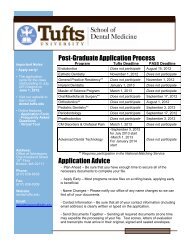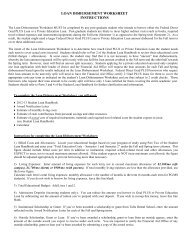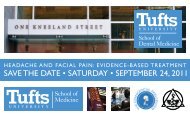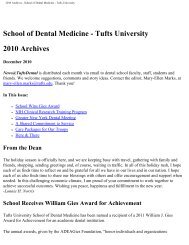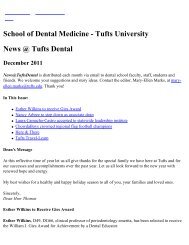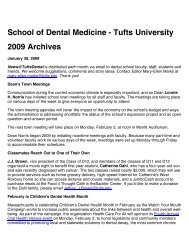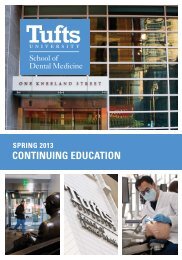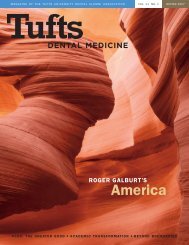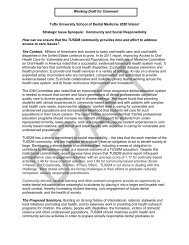Spring 2013 - Tufts University School of Dental Medicine
Spring 2013 - Tufts University School of Dental Medicine
Spring 2013 - Tufts University School of Dental Medicine
You also want an ePaper? Increase the reach of your titles
YUMPU automatically turns print PDFs into web optimized ePapers that Google loves.
Left, the exterior <strong>of</strong> <strong>Tufts</strong> College <strong>Dental</strong> <strong>School</strong>, 1918;<br />
below left, women students from the dental and medical<br />
schools in 1917, with Erna Neumann front row, far left;<br />
below right, Neumann at Commencement, June 17, 1918.<br />
Above, some<br />
<strong>of</strong> Neumann’s<br />
dental tools;<br />
right, the<br />
dental school<br />
infirmary, as<br />
shown in the<br />
1918 Dentufts<br />
yearbook.<br />
the governess<br />
goes to school<br />
Erna Neumann and her sister Kathe arrived<br />
in Boston on April 9, 1914. They had left<br />
Germany to spend a year in the United States<br />
as governesses. Their first stop after docking<br />
was for a drink, and Erna was able to give<br />
America a hint <strong>of</strong> her copious stores <strong>of</strong> pluck<br />
when the waiter refused to serve her a beer<br />
because she was not yet 20.<br />
“What” she asked incredulously. “And<br />
this should be a free country”<br />
Still, she found America intoxicating.<br />
“Everything was just so delightful for us,”<br />
she recalls on a scratchy audiotape, her accent<br />
only slightly mellowed with age.<br />
Just a few months later, though, war broke<br />
out in Europe. Their family thought it would<br />
be safer for the sisters to stay away for a while.<br />
After all, how long could the war last<br />
But the fighting dragged on, and the sisters<br />
were soon cut <strong>of</strong>f from their family.<br />
Neumann needed a plan for her future. She<br />
was interested in dental school, but she had<br />
only $225 in the bank from her governess<br />
job, an amount that would barely pay the first<br />
year’s tuition. A minister she had befriended<br />
encouraged her to apply anyway. Deciding<br />
which school wasn’t much <strong>of</strong> a problem.<br />
There were only two dental schools in the<br />
area, and only one accepted “girls.”<br />
“So,” the minister said, “your choice is<br />
<strong>Tufts</strong>.”<br />
Neumann didn’t sleep for a few nights<br />
after she was accepted. “I almost thought<br />
lightning struck me,” she writes. “Can you<br />
imagine the decision to make, all alone in<br />
this country” In the end she enrolled, with<br />
the understanding that she could stay with<br />
the minister’s family, sharing a bed with his<br />
sister-in-law and paying $3 a week for room<br />
and board while her money lasted.<br />
The 1918 dental class began as a group <strong>of</strong><br />
237 men and seven women. In the Dentufts<br />
yearbook, her classmates describe their first<br />
gathering, in September 1915: “When …<br />
each <strong>of</strong> us ran our eyes over the throng, all<br />
invariably stopped to rest a moment longer<br />
on the blushing countenance <strong>of</strong> our Erna; <strong>of</strong><br />
course she looked down quite demurely.”<br />
Yet soon, they wrote, she was known for<br />
her “assiduous application to her studies.”<br />
One <strong>of</strong> their first assignments was to carve<br />
teeth out <strong>of</strong> ivory in the “Technic” laboratory.<br />
She recounts the groans to be heard<br />
when an instructor put his calipers to the<br />
carvings and proclaimed, “Sir, this is just a<br />
trifle too deep here—start a new one!”<br />
The students were also charged with making<br />
their own dental instruments. Neumann<br />
recalled these tools being dark-colored<br />
(stainless steel not yet readily available) and<br />
not things they used in practice.<br />
Neumann writes fondly <strong>of</strong> Pr<strong>of</strong>essor<br />
George Bates, who taught histology, and<br />
Pr<strong>of</strong>essor Robert Andrews, who taught<br />
physiology. (Both men are honored every<br />
year at <strong>Tufts</strong> on Bates-Andrews Day, which<br />
celebrates and showcases the work <strong>of</strong><br />
ElEctric drills bEing not yEt common for studEnts,<br />
nEumann and hEr classmatEs had to purchasE<br />
hEavy, pEdal-drivEn machinEs—not unlikE<br />
spinning whEEls—to powEr thEir dEntal drills.<br />
26 tufts dental medicine spring <strong>2013</strong>



